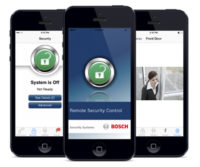Intrusion panels are seeing some big changes. New communications options have made systems more interactive and have made it easier to integrate the panel with other systems. Today’s panels also are smarter than those of the past, simplifying the user experience and reducing system costs.
Those new capabilities have created new opportunities for security dealers — including new sources of recurring monthly revenue, lower cost installation and more engaged and loyal users.
Hot Home Automation
Some of the biggest technology developments impacting intrusion panels actually originated outside the security industry. Take the boom in home automation capability.
“The tipping point was the smartphone,” observes Mark Hillenburg, executive director of marketing for Springfield, Mo.-based equipment manufacturer Digital Monitoring Products. “Home automation has been around for decades but it never really happened until the smartphone became ubiquitous. You already paid $400 for an interface for the home. For a relatively low amount of investment you can add all these other things.”
Homeowners really like the idea of being able to lock doors, adjust lighting and control other functions remotely using their smartphone — so much so that Hillenburg expects the percentage of homes with security systems to increase from the traditional 20-some percent range.
From the dealer’s point of view this should yield increased sales, a higher average sale and increased recurring monthly revenue, as most dealers charge an extra monthly fee for interactive control. Hillenburg also noted that large national security dealers have seen customer attrition reduced by 5 percent among accounts that have interactive capability.
As smartphones take on an important role in controlling intrusion panels, some manufacturers are rethinking the traditional approach of installing a keypad near the panel and wiring the two together.
Nashville-based manufacturer Resolution Products, for example, minimizes the cost of equipment and labor by eliminating the keypad and having homeowners rely instead on smartphones or tablets to control the system. This also eliminates the need to install the panel near where an end user would want the keypad to be.
The Resolution Products controller doesn’t even use a traditional cabinet design. It’s smaller, it’s encased in plastic and it looks more like a Wi-Fi hotspot. As Resolution Products Vice President of Marketing Dave Mayne explains, the controller is designed to be installed near the home’s broadband router. And that, in turn, overcomes one of the major hindrances to using the customer’s broadband service for connectivity to the central station, making network connectivity a more viable alternative to a traditional phone line or wireless data connection than in the past.
Several dealers and manufacturers interviewed for this article say they have been selling more networked systems in the last 12 to 18 months — an option that can minimize the customer’s monthly bill by eliminating the cost of a cellular connection. John Bazyk, director of sales and marketing for East Granby, Penn.-based security dealer Command Corporation, says he prefers to sell networked systems because they offer more bandwidth than cellular data or a traditional phone line — and that speeds and simplifies remote software downloads or changes to panel programming.
Like Resolution Products, Melville, N.Y.-based Honeywell Security also has made it easier to install a networked system, but has done so in a different manner. The company offers a wireless security panel that communicates using Wi-Fi, eliminating the need to run a wire from the control to the local router.
Rob Puric, director of Connected Home for Honeywell Security, estimates that it takes between one and a half or two hours to install a networked system with a Wi-Fi touchscreen, which he says is a significant reduction in the time required for a typical wired system.
And as Puric notes, Wi-Fi offers other benefits as well — including the potential to easily add a video camera in the future and providing a more economical alternative to cellular for supporting two-way voice capability.
Z-Wave and ZigBee
Wi-Fi isn’t the only new communications option. Z-Wave and ZigBee, two low-bandwidth, low-power wireless communications options, are also gaining traction. Both technologies are standards-based and are used in other industries, which should drive ongoing economies of scale.
The advent of Z-Wave and ZigBee has unleashed a wave of creativity in wireless sensor design, as manufacturers devise a range of applications leveraging two-way communications capability. For example, Honeywell offers a Z-Wave device that shuts off a home’s water supply in response to a command from the panel when a leak is detected.
Z-Wave and ZigBee door locks that can be unlocked in response to a command from a smartphone using a control panel’s interactive capability are also hot. Tom Mechler, product marketing manager for Fairport, N.Y.-based manufacturer Bosch Security Systems, sees Z-Wave and ZigBee locks having strong appeal to small businesses as well as homeowners.
“They no longer have to have a bunch of keys and they can change the code remotely,” Mechler observes. Systems also can be set up so that the alarm system is disarmed when the door is unlocked, which helps to minimize false alarms when an employee doesn’t know or can’t remember the code to the alarm system.
By using a panel with home automation designed primarily for residential use, small businesses also can gain an easy way to save on energy costs by programming the system to adjust the temperature when the system is armed or disarmed, Mechler notes.
With the cost of components declining, some panels now support multiple types of communication, such as Z-Wave and Wi-Fi — even traditional one-way communications at frequencies traditionally used by competitors. The latter capability, available on 2Gig panels from Carlsbad, Cal.-based manufacturer Linear, enables an alarm company to re-use wireless sensors that were previously installed in a customer location, minimizing the cost of a new installation.
“Our panel works on the 345 MHz frequency without having to add anything to it,” explains Adam Krueger, director of sales for Linear. Customers with those devices “can program right into our panel — and there’s a lot of these devices out there,” Krueger adds.
Video Capabilities
Some of today’s intrusion control panels also have new video capabilities. For example some panels now can receive a signal from a video camera and treat it as an alarm or other alert.
Miami Beach, Fla.-based security dealer York Security Systems has used this capability to help one commercial customer keep tabs on a parking space that has a 15-minute time limit, explains Jamie Bienenfeld, vice president for the company. Video analytics in the camera can recognize when a car pulls in to the space, thereby alerting the panel, which generates an alert when 15 minutes have passed.
Another development on the video side involves keypads that have built-in cameras.
Cupertino, Calif.-based manufacturer Qolsys offers an Android keypad that uses a built-in camera to capture an image of everyone who disarms the system. The image is stored locally, and in the future, will also be stored on servers in a remote data center, explains Mike Hackett, Qolsys vice president of sales and marketing.
More Engaged Customers
Clearly, the last couple of years have seen major changes in intrusion panels — from home automation to new forms of communications, new video capabilities and more. And as Bienenfeld puts it, capabilities such as these “keep customers engaged.”
Traditionally some people with alarm systems get out of the habit of arming and disarming them — a situation that sometimes causes them to question why they’re paying a monthly monitoring fee and to drop service. But with all the new capabilities in today’s systems, customers are more likely to use their systems.
“And as long as they’re using it they’re happy to pay for it,” Bienenfeld observes.
What’s Next for Intrusion Panels?
Moving forward, the alarm industry is likely to continue to benefit from technology developments occurring in other industries.
Smartphone manufacturers are expected to begin putting Bluetooth and near-field communications (NFC) into more devices. NFC is intentionally designed to operate over short distances, making it suitable for mobile transactions or, in the case of the alarm industry, potentially enabling homeowners in the future to disarm their systems using their smartphone.
“They will walk up and unlock the door and disarm the system,” predicts Patrick Egan, CEO of Lancaster, Penn.-based security dealer Select Security.
Technology developments eventually could obsolete the alarm panel, observes Keith Jentoft, president of St. Paul, Minn.-based manufacturer Videofied. Some manufacturers are already working on building control panel functionality into a credit card-sized board that will work in combination with a customer’s router, Jentoft notes.
And with systems becoming increasingly interactive, Jentoft believes the functionality built into the portal through which customers interact with their system will be increasingly important and will take on more and more of the software functionality that traditionally has resided in the panel.
MORE ONLINE
Check out SDM’s previous coverage on intrusion panels:





